|
The commissioning of the DAHLIA represented a number of Lighthouse Board "Black Fleet" firsts on the Great Lakes. Not only was she the first vessel specifically designed as a lighthouse tender, but she was also the first Great Lakes tender to be constructed with an iron hull, and first USLHS vessel on the lakes to be named in accordance with a protocol of naming all tenders with botanically inspired names. At the dawn of the 1870's The Eleventh Lighthouse district found itself responsible for over 100 lighthouses, 7 steam fog signal stations and 145 buoys spread widely throughout lakes Huron, Michigan and Superior. With only the steamer WARRINGTON and the schooner BELLE available for service on a full time basis, and the steamer HAZE shared with the Tenth district, the need for another vessel to service so many widely scattered aids to navigation was clear, and Eleventh District Engineer Orlando Poe requested funding for a new vessel to be dedicated to service in the district. Congress responded favorably to the request on March 3, 1873 with an appropriation of $90,000 for the vessel's construction, and a contract for the vessel's construction was awarded to Philadelphia shipbuilder Neafie and Levy on June 11 that same year.
Over the following ten years, the number of aids to navigation in the district increased significantly, and the vessel was now servicing 140 lighthouses, 28 fog signal installations and 183 buoys on an annual basis. To this end, a larger crew was needed to handle the work, and she was laid up at the end of the 1881 navigation season and along with strengthening of her upper decks, her crew accommodations were enlarged and her engines completely overhauled. Four years later, her capstan and chain stoppers were transferred to the upper deck to increase the available area for crews quarters on her forecastle. With continued expansion in the number of aids to navigation, it became clear that the Eleventh District was too large to effectively manage as a single entity, and the Lighthouse Board recommended that a new district be formed to take responsibility for aids on Lake Michigan which represented the largest area of expansion. Congress concurred with the plan, with the new Ninth Division responsible for Lake Michigan formed at the opening of the 1877 navigation season. Concurrent with this change, DAHLIA was transferred as the sole inspection tender for the new Ninth District on April 1 of that year.
In October 1891, DAHLIA steamed to Toledo to pick up new lightships LV55, LV56 and LV57 which had been built for service in the Straits of Mackinac, and towed them to the Detroit depot. After a full inspection of the three vessels, she again took them and their crews in tow and headed north to place them on their stations. At the end of the 1891 navigation season, she was employed in retrieving all of the buoys in the Ninth District. Although supposedly old and near worn-out, at the end of the 1891 season, her log books showed that during the year she had been underway a total of 166 days and steamed 5,875 miles. With visitors from the entire world expected to be in Chicago for the Columbian Exhibition in 1893, and the lighthouse Board planning on a significant presence on the waterfront, DAHLIA was dispatched to Cleveland at the end of the season, where she finally had new boilers installed and both substantive and cosmetic changes made to her crew quarters and superstructure. This refit was evidently wholly successful, as she steamed an incredible 9,915 miles while supplying light stations and tending buoys in the 1894 navigation season, and in testament to her revitalized condition Ninth District Engineer Milton B. Adams commented that she was "in condition to meet the requirements of the district for a number of years to come."
While the new 168' 10" long tender SUMAC was delivered to the District in 1903, DAHLIA continued to serve as the primary inspection, supply and buoy tender for the district, steaming an average of 9,000 miles every season. However, after 36 years of faithful service, it was felt that she had outlived her useful life, and she was offered for sale at auction in 1909.
With clearing ice, the
vessel sank in 28 feet of water, and with her submarine remains
considered a hazard to navigation, she was dynamited by the Army Corps
of Engineers. |
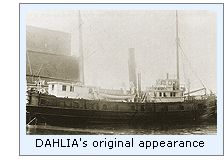 Plans
for the vessel specified an iron hull of 141' 6" overall length and
129' 6" at the waterline. With a beam of 25', she was to draw a
shallow 5' 7", facilitating her working in close proximity to
navigational aids in shallow water. Her single screw was powered by a
single 225 horsepower coal-fired steam engine, and resulted in a total
fully loaded displacement of 426 tons. Launched on February 16, 1874,
and after sea trials she steamed to Detroit where she was placed into
commission serving as an inspection, supply and buoy tender that May.
Plans
for the vessel specified an iron hull of 141' 6" overall length and
129' 6" at the waterline. With a beam of 25', she was to draw a
shallow 5' 7", facilitating her working in close proximity to
navigational aids in shallow water. Her single screw was powered by a
single 225 horsepower coal-fired steam engine, and resulted in a total
fully loaded displacement of 426 tons. Launched on February 16, 1874,
and after sea trials she steamed to Detroit where she was placed into
commission serving as an inspection, supply and buoy tender that May.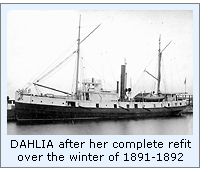 Between
July 1889 and 1890, DAHLIA made 170 supply visits to the lights around
Lake Michigan, steaming a total of 3,315 miles and consuming 464 tons of
coal in the process. Now almost twenty years old, and her aging engines
slowing her progress, Ninth District Major William Ludlow was concerned
that she was no longer up to the task at hand, and advertised for bids
for the a complete upgrading of her mechanical systems. When no cost
effective bids were received, and requested funding for her replacement
with a larger and faster vessel. With no response relative to that
funding, she continued to be pressed into service.
Between
July 1889 and 1890, DAHLIA made 170 supply visits to the lights around
Lake Michigan, steaming a total of 3,315 miles and consuming 464 tons of
coal in the process. Now almost twenty years old, and her aging engines
slowing her progress, Ninth District Major William Ludlow was concerned
that she was no longer up to the task at hand, and advertised for bids
for the a complete upgrading of her mechanical systems. When no cost
effective bids were received, and requested funding for her replacement
with a larger and faster vessel. With no response relative to that
funding, she continued to be pressed into service.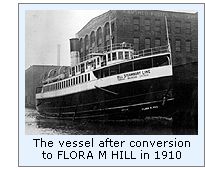 On
November 23, 1901, she again took the light vessels LV55, LV56 and LV57
in tow, and took them to Sturgeons Bay shipyards where they were to be
completely overhauled in readiness for the next season's duty. While at
the shipyards, she also had her bulwarks, strakes and main decks renewed
and her forecastle deck calked. She also had a new donkey engine boiler
and new cast iron bridge walls installed on the main boiler. On April
18, she again took the lightships in tow, and replaced them on their
stations in the Straits.
On
November 23, 1901, she again took the light vessels LV55, LV56 and LV57
in tow, and took them to Sturgeons Bay shipyards where they were to be
completely overhauled in readiness for the next season's duty. While at
the shipyards, she also had her bulwarks, strakes and main decks renewed
and her forecastle deck calked. She also had a new donkey engine boiler
and new cast iron bridge walls installed on the main boiler. On April
18, she again took the lightships in tow, and replaced them on their
stations in the Straits.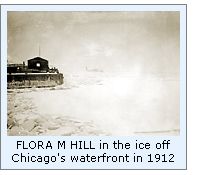 At
the auction held on February 17, 1909, the Hill Steamboat Company's bid
of $5,400 was the highest entered, and Hill became her new owners. Over
the following year, DAHLIA received a new boiler of 11' 6: diameter and
12' in length equipped with three corrugated furnaces, and her decks and
superstructure completely refitted to afford comfortable passenger
quarters. Re-christened FLORA M HILL in honor of the owner's wife, the
vessel was successfully submitted for inspection by the government
inspector at Kenosha in January 1910, and was placed into service
carrying passengers and light cargo between Chicago and Green Bay at the
beginning of the 1910 navigation season.
At
the auction held on February 17, 1909, the Hill Steamboat Company's bid
of $5,400 was the highest entered, and Hill became her new owners. Over
the following year, DAHLIA received a new boiler of 11' 6: diameter and
12' in length equipped with three corrugated furnaces, and her decks and
superstructure completely refitted to afford comfortable passenger
quarters. Re-christened FLORA M HILL in honor of the owner's wife, the
vessel was successfully submitted for inspection by the government
inspector at Kenosha in January 1910, and was placed into service
carrying passengers and light cargo between Chicago and Green Bay at the
beginning of the 1910 navigation season.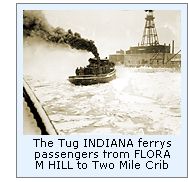 While
attempting to make entry into Chicago harbor through heavy ice on March
11, 1912 with a light compliment of passengers and a load of automobile
headlights, FLORA M HILL became irretrievably stuck in the thickening
ice. Unable to free herself, and finding her hull breached by increasing
pressure of the shifting ice, there was concern that she would soon go
to the bottom, and the steam tug INDIANA managed to make her way out of
the harbor to transfer all passengers to the relative safety of the
nearby Two Mile Crib.
While
attempting to make entry into Chicago harbor through heavy ice on March
11, 1912 with a light compliment of passengers and a load of automobile
headlights, FLORA M HILL became irretrievably stuck in the thickening
ice. Unable to free herself, and finding her hull breached by increasing
pressure of the shifting ice, there was concern that she would soon go
to the bottom, and the steam tug INDIANA managed to make her way out of
the harbor to transfer all passengers to the relative safety of the
nearby Two Mile Crib.